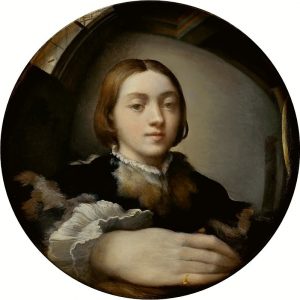
Mazzuoli's "self portrait in a convex mirror"
On this day of 11 January 1504, Francesco Mazzuoli was born in Parma, a part of the Lombard region. Mazzuoli lost his father at a tender age and was thereafter raised by his paternal uncles, who were both themselves painters. His uncles were caring individuals who sought to ensure as proper an education as possible for the young Mazzuoli. It became clear when he was rather young that Mazzuoli possessed an artistic eye and hands that followed, as he began drawing when he should have been learning to write. Recognising this talent, Mazzuoli’s uncles sought out the best masters they could to instruct Mazzuoli in the art of painting.
By the age of 19, Mazzuoli had, as was typical, completed several religious-themed paintings. He had also completed frescoes for a chapel, adding to his overall skills as a painter. Mazzuoli expressed a desire to go to Rome, to which his family acquiesced. Before leaving for Rome, he completed a self-portrait on a round wooden surface by copying his reflection from a convex mirror. This portrait he brought with him to Rome and the Pope was very much impressed by it. The Pope commissioned Mazzuoli to complete at least one work, the Circumcision, which later wound up in the hands of another. Others of his body of work came to be owned by Charles V, Holy Roman Emperor.
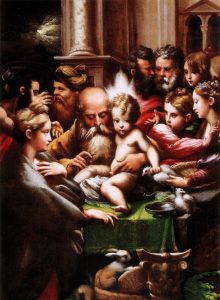
The Circumcision of Jesus
Mazzuoli’s instruction was interrupted by the sacking of Rome in 1527. He was able to live on somewhat peacefully despite the barbarism of the Holy Roman Emperor’s German soldiers in that he painted watercolours to serve as ransom for the Germans. Unfortunately, while on an outing, he was intercepted and captured by a different group of soldiers, and had to pay what little money he had as a ransom.
Due to the dangers now very present in Rome, Mazzuoli was recalled to Parma by an uncle. On his way back to Parma, Mazzuoli dallied in Bologna for quite a long while. He made friends with another artist who helped make copper plates and woodcuts of Mazzuoli’s work. This friend turned out to be false when he stole all the plates, woodcuts, and several of Mazzuoli’s drawings, then was never heard from again. Mazzuoli recovered everything except the drawings. The entire event took its psychological toll on the young man, who then threw himself into his work.
Mazzuoli almost had a very fortuitous time with Charles V. He painted a charming portrait of the Emperor with a wee Hercules handing the Emperor the world. A meeting was arranged between the Emperor and Mazzuoli, but Mazzuoli refused to turn over the portrait to Charles V. Thus, no reward or benefice was forthcoming for Mazzuoli. After this episode, Mazzuoli finally returned to his native Parma.
Mazzuoli’s life took an interesting turn once he arrived back in Parma: he determined to become an alchemist. Mazzuoli figured he could become rich more quickly through alchemy than through painting. Mazzuoli was right in the middle of painting frescoes for a church when he took up his new interest and subsequently slacked off so much that a lawsuit was brought against him for the return of the advanced payment. Mazzuoli did wind up finishing the work.
Still heavily involved in alchemy, Mazzuoli developed a sort of mad obsession for the art. His hair and beard grew long and unkempt. During his most intense period of alchemical work, Mazzuoli ceased to paint. Finally, Mazzuoli fell ill at the age of 36 and died on 24 August 1540. Per his request, Mazzuoli was buried naked with a cross made of cypress wood.
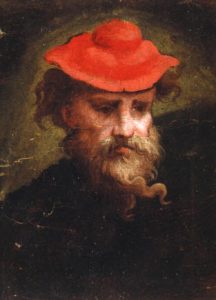
Self-portrait 1540
Mazzuoli was a fantastically prolific painter. His early death was a great loss to the art world, as was the early loss of Raphael. Mazzuoli left many fine paintings and frescoes, such that we may yet see them today. If you are ever at the British Museum, you can observe some of his works there.
Heather R. Darsie lives in the United States with her family and three parrots. She works in the legal field, with a focus on children. She obtained a Bachelor of Arts degree in German Languages and Literature, then a Juris Doctorate in American jurisprudence, and studied abroad in Costa Rica and France. Heather has always loved history. She first became acquainted with Elizabeth I when she was in middle school and chose to write a book report about her. Since then, she has always held an interest in the Renaissance and its numerous enigmatic citizens, with particular focus on the history of England and Italy. She is currently working on a book on the heraldry of Tudor women and is also researching Anne of Cleves.
Sources & Suggested Reading
- Vasari, Giorgio. The Lives of the Artists. First edition published in 1550. http://members.efn.org/~acd/vite/VasariParmigianino.html
- British Museum. “Francesco Mazzuoli.” http://www.britishmuseum.org/research/collection_online/collection_object_details.aspx?

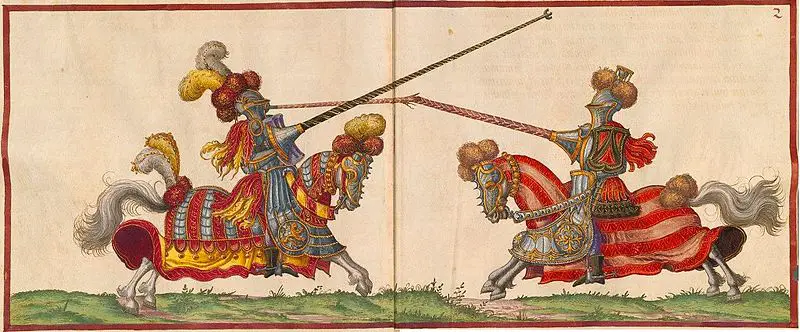
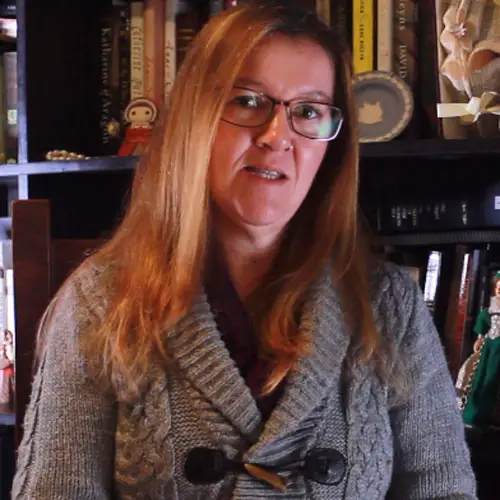
Leave a Reply